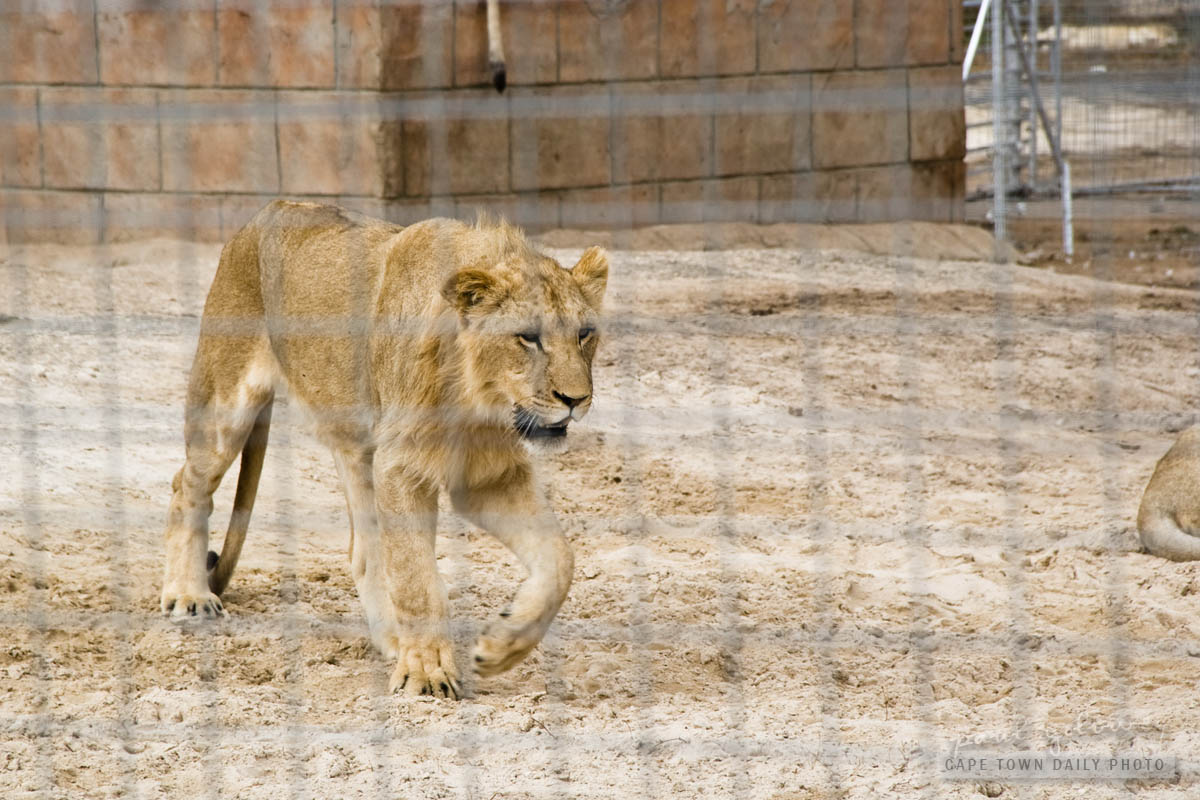
We paid our R70 entrance fee and walked the short distance to the enclosures to see the lions. Our visit lasted about 30 minutes, and the above aside, I can't say that it was worth the entrance fee - and can safely say that we won't feel the need to visit again.
Just to clarify, I fully support rehabilitation and conservation projects - even those that preserve animals who could never be reintroduced into the wild. However, I found no information on Cape Town Lion Park's website, besides for a reference to "education" to indicate that they were involved in conservation.
- Female White Lion
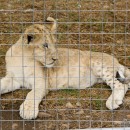
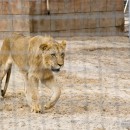
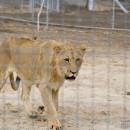
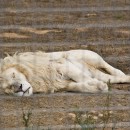
Ali
I think, the same counts for the Joburg Lion Park which, by the way, also accommodate white lions. I also had the feeling that this park lays its focus clearly on commercial aspects rather than conservation.
Alex Bond-Smith
I worked as a tourist guide for 8 years and there are unfortunately a whole lot of places that have been established to make money out of (mostly) tourists that call them selves names such as “Outreach program”, “Private Game Reserve”, “Sanctuary” etc etc. They are all actually just a Zoo.
rid1
Shoulda spent the R70 to enter tygerberg zoo instead…
Andy Gladwish
We visited South Africa in February and Cape Town in particular. We were advised to visit Drakenstein Lion Park near Paarl. It was a fascinating experience – they specialise in rescuing captive lions and bringing them back to health. All the enclosures were large with shade provided by tree’s or man-made structures. Definately a place to visit if you are interested in Lion conservation. The guides are very experienced and knowledgable.
Paul
Post authorAh, yes Ali – I’m sure I’ve been there also. Was that the park that you drive through? I recall there being plenty of trees – which is far better than large sterile cages. I don’t mind the commercial aspect really as long as the animals are kept in more natural environments… the medium-size square cages doesn’t sit well with me.
Alex – too true.
Rid1, you’re actually right. I’ve heard that the Tygerberg Zoo rescues mistreated animals that can’t be reintroduced into the wild. I believe, as always, they desperately need funding.
Thanks Andy, it’s good to know. I’ll make an effort to visit and see what they’re about.
Ali
Of course, Paul. The park has a lot of trees. The problem in the lion area is that one doesn’t have enough space to drive through. Too much people use to block the ways with running motors very close to the animals. Therefore, I prefer the Rhino & Lion Park where there’s a bigger distance between lions and cars.
Paul
Post authorYeah, you’re right Ali.
Rudi Strubbe
Hi Paul,
You should definitely visit Drakenstein Lion Park. What Paul Hart and his team are doing for the lions that they are accommodating is truly admirable.
The Cape Town Lion Park has actually gone through a lot of trouble trying to surf on the reputation of Drakenstein Lion Park, creating confusion down to the point of someone mixing the two up on Google maps …
While Cape Town Lion Park near Stellenbosch relates to wildlife protection and care like Adolf Hitler to human rights (ever wondered whose lions are on display … until of age to go back to the farm …?), Drakenstein on the other hand is worth every penny spent. Each animal that has found sanctuary in Drakenstein comes with a sad story of abuse. Some of them only realised that they were actually lions upon arrival at Drakenstein.
Paul
Post authorThanks for the info Rudi – as I mentioned to Andy, I’ll be sure to visit Drakenstein. :)
Rudi Strubbe
You’re welcome!
A.W.C.T.Z (African Wildlife Conservation Trust Zimbabwe)
White Lion Breeding Is Not Conservation!
As a ‘man made’ animal they are not a conservation issue. There is no official studbook for White Lions and talks of re-introduction are as dangerous as they are pointless.
The white lion is occasionally found in wildlife reserves in South Africa and is a rare color mutation of the Kruger subspecies of lion (Panthera leo krugeri). It has been perpetuated by selective breeding in zoos around the world. White lions are not a separate subspecies and they have never been common in the wild. Regarded as divine by locals, white lions first came to public attention in the 1970s in Chris McBride’s book The White Lions of Timbavati. The greatest population of white lions are in zoos where they are DELIBERATELY bred for colour.
White Lions, like White Tigers are becoming increasingly popular in Zoos. There is even talk of ‘returning’ them to the wild. This borders on the ridiculous because like the White Tiger they are a manufactured animal… something created by man. White Tiger Breeding Is Not Conservation and neither is breeding of the White Lion.
The White Lion is NOT a rare, endangered species.
The White Lion is a meal ticket for people who seek to try and use an animal that is just a little different for their own motives. It is a return to the circus freak show.
Serious zoos (good zoos) should really address the facts and not jump on the mis-propaganda bandwagon.
BeeTee
Luckily the Cape Town Lion Park seems to be closed! Great! Bee
Paul
Post authorI wonder what happened to the Lions BeeTee. :-/
Rudi Strubbe
Would be absolutely great news that this infamous place was closed!
As for the lions, I have no illusisons. For the ownere, the lions were something to make money with, one way or another. Unless they were somehow rescued, I guess they are somewhere at a canned lion hunting farm, if not already shot … Would love to learn I’m dead wrong on this one though.
Charalta Bruwer
Hi Guys
Sorry to only come across all your comments now. I am an employee of Vredenheim wine farm. So i would just like to give some answers to your questions. Cape Town Lion Park is no longer open. The owner of the lions, have taken them back to his lion farm in the Kalahari. And no they are not part of can hunting.
Vredenheim has since managed the park themselves. You can have a look on our website. We have really given the park a big face lift (like providing more shade and even a place for our tigers to swim in). Our owners are game lovers and have had game since forever. We are very proud of our park and are growing by the day. We currently have white and brown lions, tigers, leopard, cheetah and lynx. all of the mentioned cats were born in captivaty and we try and keep them as natural as possible. Cape Nature and the DBV visit us on a regular basis and are very happy with what we do for this majestic animals. We give home to these animals to ensure they dont become instict and to teach our children about these animals.
So I hope to see you all visiting our park and get some great facts about them from our guides. We are also learning more and more about these animals and will try and create the best space for them as we go along. We charge an affordable rate of R50 per adult and R30 for children.
Please send me an email if you need any other information. Its diffucult to give feedback on all your complaints as these weren’t our cats.
Paul
Post authorHi Charalta – thanks for the update. I’m really glad to hear that the lions have been moved; they never seemed happy at all. Perhaps we should visit Vredenheim again and do a follow up article.
Rudi Strubbe
Hello Charalta, With regard to the owner of the lions that used to populate the “Cape Town Lion Park”, I would gather that this is what you guys were told or like to believe. Sure, it makes a lot of sense to simply keep a bunch of lions in the middle of the Kalahari just for the fun of it, and nooooo, hunting is not in scope. Wake up, please. I met that man and took his picture. Later, I got a positive identification on that picture, putting him right into canned hunting …
Anyway, that is history, but what does today bring? I know Vredenheim and I go there a couple of times a year to visit the Barrique restaurant (nice place, good food!). I know the owner of the place runs his own private little zoo. So now he has lions and tigers and god knows what… This is just one more place where animals born in captivity are getting bored to death and where. It is just another tourist trap, and it is about the money, no more…
Tygerberg zoo, meanwhile, has apparently gone bankrupt. And the care of some high profile animals has been left to that other place, Drakenstein Lion Park. Paul hart is now investing heavily to be able to properly house and feed a whole range of animals left behind in the bankruptcy, such as chimps and tigers… Derelicts of the money-making business that Vredenheim is now getting into. South-Africa is a beautiful country, where you have great opportunities to see wildlife. There is no need to go the likes of Vredenheim, but if you really want to see animals in captivity, you’re better off to visit Drakenstein Lion Park. At the very least, this place is there for the right reasons. It is there to pick up where others have misbehaved or fell short of their commitment to the animals that they had depending upon them. Whereas the common zoo or Vredenheim-type wannabee is the expression of greed, the rare places like Drakenstein Lion Park express responsibility and compassion, the better side of man!
Bee
Breeding white lions has nothing, but about nothing to do with conservation.
It does not matter if its the CT Lion Park or any celebrity park in SA or in the world.
Its against nature the same nonsense than keeping Cheetaks at Strand,all onlöy for money making purposes.
catherine
I visited Vredenheim in February 2013. How awful and depressing!! The Male and Female White Lions are right in the front, separated. The enclosures are just too disgusting. Only a little canopy right near the fence that they have for shelter. No grass or anything remotely like that. There are a row of chairs in front of the fence and the only way these lions can have the freedom of choice not to interact with humans is by them turning their backs to the fence (and chairs)!!! Clearly they were positioned in the front (there were tawny lions in another section, but not accessible to the public) – as the drawing card. There were also rabbits, who were exposed to the sun – their shelter was locked!! So they were all sitting on top of each other in the tiny bit of shade available to them. The energy from these animals is one of lethargy, boredom and absolutely no freedom of choice – they are forced by nature of their enclosures to be accessible to humans. What my intuition is screaming to me, – these animals are merely the drawing card, so people will come and then eat at the exhoribrantly priced restaurants and buy their expensive wine. A greed-induced ploy. Defintely the animals best interest is not at heart here. Now – a totally different scenario at the Drakenstein Lion Park. Paul and his staff absolutely put their Lions first. They are well cared for and most importantly – have enough space and lots of long grass and trees to retreat from humans if they do not want to interact with people. These are rescued lions who have been horrendously abused by humans, so it is truly amazing to me and I attribute this to Paul and his staff – that they actually do choose to have interaction with humans. Vredenheim’s animals should be given to Paul – where they will thrive and be happy, well-loved and 100% taken care of and certainly not exploited. These poor animals have been sacrificed at the altar of money and greed!
Belinda
I was at Drakenstein last year and most impressed by the place I don’t think it is right to keep animals caged but drakenstein has filled a void without which these regal beasts would have continued to suffer atrocious mistreatment. I went there as my 6 year old son was not permitted on the lion drive at Mabula because of the age restriction and he wanted to see lion. To get that close to these animals was fantastic. At the time they told me they were giving safe haven to other animals in 2013 and I plan to go back next week to visit the rescued tiger pair and of course those obnoxious crows. Well worth the money spent.